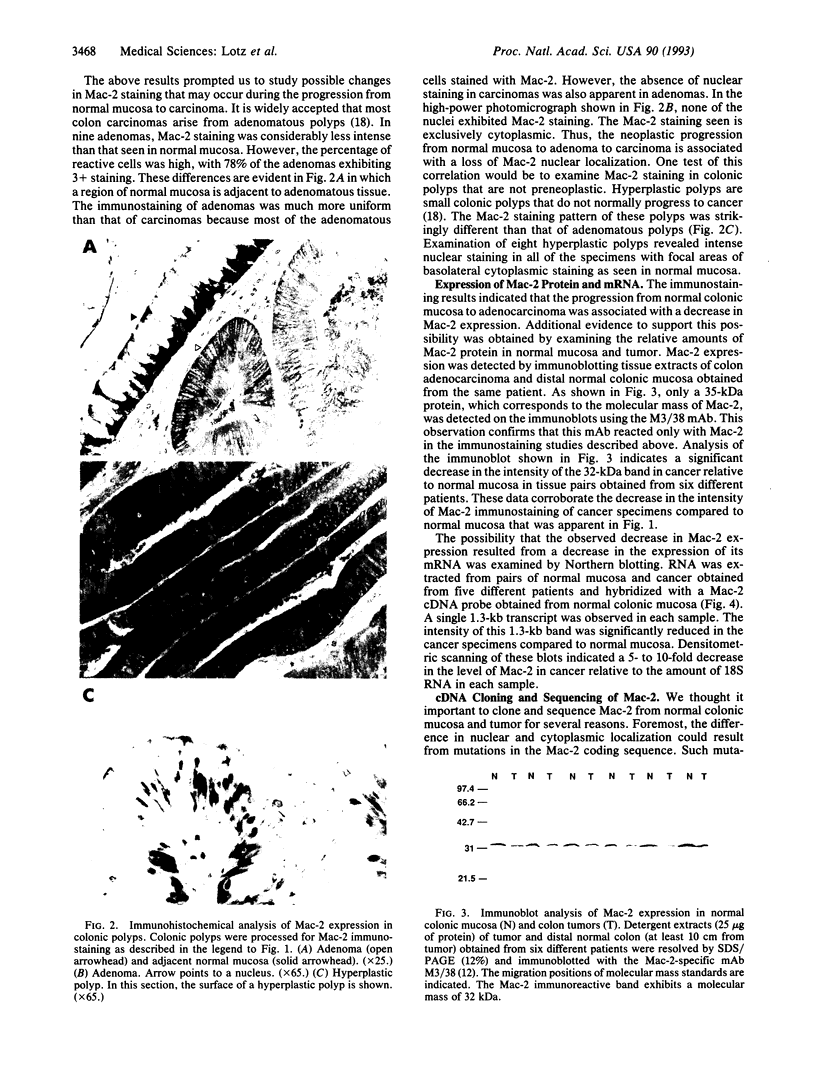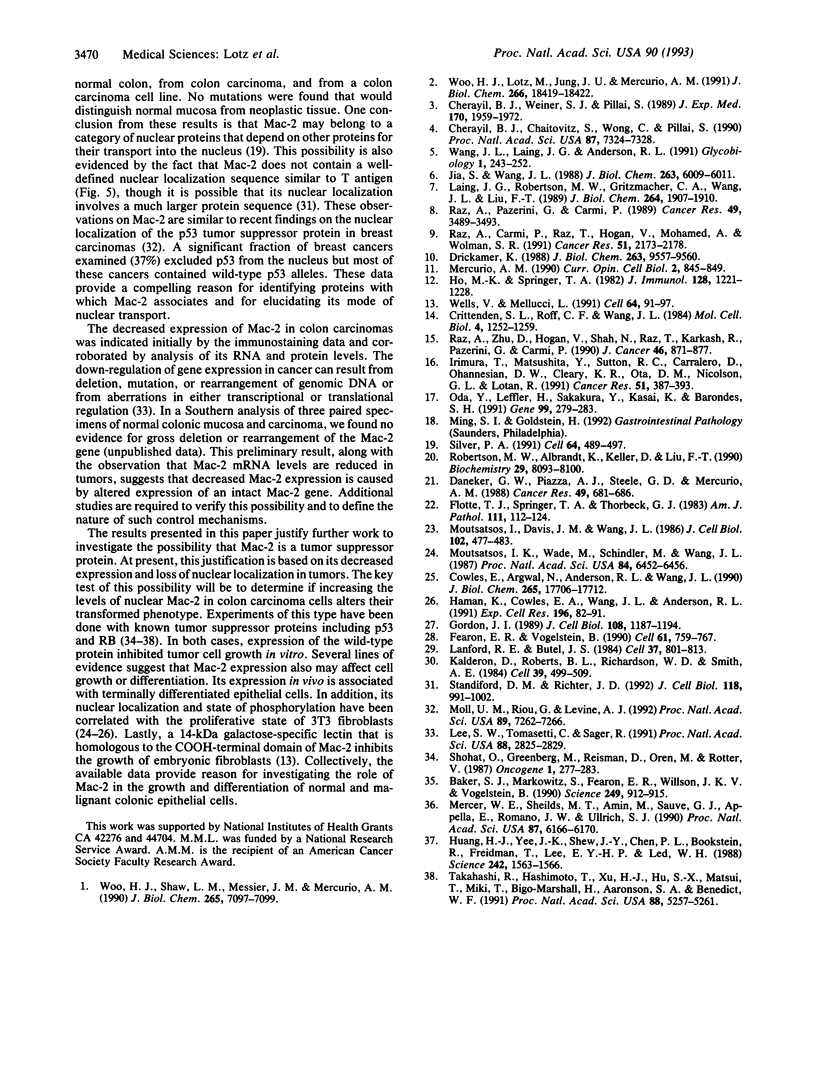Abstract
The Mac-2 lectin (carbohydrate binding protein 35) is a soluble, 32- to 35-kDa phosphoprotein that binds galactose-containing glycoconjugates. We report here that the colonic epithelium is a major site of Mac-2 expression in vivo based on immunohistochemistry of human tissue specimens. In this epithelium, proliferating cells at the base of the crypts do not express Mac-2 but its expression increases with differentiation along the crypt-to-surface axis. Mac-2 expression is concentrated in the nuclei of these differentiated epithelial cells. The progression from normal mucosa to adenoma to carcinoma is associated with significant changes in Mac-2 nuclear localization and expression. In all adenomas (9/9) and carcinomas (13/13) examined, Mac-2 was not present in the nucleus but was localized in the cytoplasm. Sequencing of Mac-2 cDNAs from normal mucosa and carcinoma revealed no specific mutations that could account for this loss of nuclear localization. We also observed a 5- to 10-fold decrease in Mac-2 mRNA levels in cancer compared to normal mucosa as well as a significant reduction in the amount of Mac-2 protein expressed. These observations suggest that Mac-2 exclusion from the nucleus and its decreased expression may be related to the neoplastic progression of colon cancer.
Full text
PDF




Images in this article
Selected References
These references are in PubMed. This may not be the complete list of references from this article.
- Baker S. J., Markowitz S., Fearon E. R., Willson J. K., Vogelstein B. Suppression of human colorectal carcinoma cell growth by wild-type p53. Science. 1990 Aug 24;249(4971):912–915. doi: 10.1126/science.2144057. [DOI] [PubMed] [Google Scholar]
- Cherayil B. J., Chaitovitz S., Wong C., Pillai S. Molecular cloning of a human macrophage lectin specific for galactose. Proc Natl Acad Sci U S A. 1990 Sep;87(18):7324–7328. doi: 10.1073/pnas.87.18.7324. [DOI] [PMC free article] [PubMed] [Google Scholar]
- Cherayil B. J., Weiner S. J., Pillai S. The Mac-2 antigen is a galactose-specific lectin that binds IgE. J Exp Med. 1989 Dec 1;170(6):1959–1972. doi: 10.1084/jem.170.6.1959. [DOI] [PMC free article] [PubMed] [Google Scholar]
- Cowles E. A., Agrwal N., Anderson R. L., Wang J. L. Carbohydrate-binding protein 35. Isoelectric points of the polypeptide and a phosphorylated derivative. J Biol Chem. 1990 Oct 15;265(29):17706–17712. [PubMed] [Google Scholar]
- Crittenden S. L., Roff C. F., Wang J. L. Carbohydrate-binding protein 35: identification of the galactose-specific lectin in various tissues of mice. Mol Cell Biol. 1984 Jul;4(7):1252–1259. doi: 10.1128/mcb.4.7.1252. [DOI] [PMC free article] [PubMed] [Google Scholar]
- Daneker G. W., Jr, Piazza A. J., Steele G. D., Jr, Mercurio A. M. Relationship between extracellular matrix interactions and degree of differentiation in human colon carcinoma cell lines. Cancer Res. 1989 Feb 1;49(3):681–686. [PubMed] [Google Scholar]
- Drickamer K. Two distinct classes of carbohydrate-recognition domains in animal lectins. J Biol Chem. 1988 Jul 15;263(20):9557–9560. [PubMed] [Google Scholar]
- Fearon E. R., Vogelstein B. A genetic model for colorectal tumorigenesis. Cell. 1990 Jun 1;61(5):759–767. doi: 10.1016/0092-8674(90)90186-i. [DOI] [PubMed] [Google Scholar]
- Flotte T. J., Springer T. A., Thorbecke G. J. Dendritic cell and macrophage staining by monoclonal antibodies in tissue sections and epidermal sheets. Am J Pathol. 1983 Apr;111(1):112–124. [PMC free article] [PubMed] [Google Scholar]
- Gordon J. I. Intestinal epithelial differentiation: new insights from chimeric and transgenic mice. J Cell Biol. 1989 Apr;108(4):1187–1194. doi: 10.1083/jcb.108.4.1187. [DOI] [PMC free article] [PubMed] [Google Scholar]
- Hamann K. K., Cowles E. A., Wang J. L., Anderson R. L. Expression of carbohydrate binding protein 35 in human fibroblasts: variations in the levels of mRNA, protein, and isoelectric species as a function of replicative competence. Exp Cell Res. 1991 Sep;196(1):82–91. doi: 10.1016/0014-4827(91)90458-7. [DOI] [PubMed] [Google Scholar]
- Ho M. K., Springer T. A. Mac-2, a novel 32,000 Mr mouse macrophage subpopulation-specific antigen defined by monoclonal antibodies. J Immunol. 1982 Mar;128(3):1221–1228. [PubMed] [Google Scholar]
- Huang H. J., Yee J. K., Shew J. Y., Chen P. L., Bookstein R., Friedmann T., Lee E. Y., Lee W. H. Suppression of the neoplastic phenotype by replacement of the RB gene in human cancer cells. Science. 1988 Dec 16;242(4885):1563–1566. doi: 10.1126/science.3201247. [DOI] [PubMed] [Google Scholar]
- Irimura T., Matsushita Y., Sutton R. C., Carralero D., Ohannesian D. W., Cleary K. R., Ota D. M., Nicolson G. L., Lotan R. Increased content of an endogenous lactose-binding lectin in human colorectal carcinoma progressed to metastatic stages. Cancer Res. 1991 Jan 1;51(1):387–393. [PubMed] [Google Scholar]
- Jia S., Wang J. L. Carbohydrate binding protein 35. Complementary DNA sequence reveals homology with proteins of the heterogeneous nuclear RNP. J Biol Chem. 1988 May 5;263(13):6009–6011. [PubMed] [Google Scholar]
- Kalderon D., Roberts B. L., Richardson W. D., Smith A. E. A short amino acid sequence able to specify nuclear location. Cell. 1984 Dec;39(3 Pt 2):499–509. doi: 10.1016/0092-8674(84)90457-4. [DOI] [PubMed] [Google Scholar]
- Lanford R. E., Butel J. S. Construction and characterization of an SV40 mutant defective in nuclear transport of T antigen. Cell. 1984 Jul;37(3):801–813. doi: 10.1016/0092-8674(84)90415-x. [DOI] [PubMed] [Google Scholar]
- Lee S. W., Tomasetto C., Sager R. Positive selection of candidate tumor-suppressor genes by subtractive hybridization. Proc Natl Acad Sci U S A. 1991 Apr 1;88(7):2825–2829. doi: 10.1073/pnas.88.7.2825. [DOI] [PMC free article] [PubMed] [Google Scholar]
- Mercer W. E., Shields M. T., Amin M., Sauve G. J., Appella E., Romano J. W., Ullrich S. J. Negative growth regulation in a glioblastoma tumor cell line that conditionally expresses human wild-type p53. Proc Natl Acad Sci U S A. 1990 Aug;87(16):6166–6170. doi: 10.1073/pnas.87.16.6166. [DOI] [PMC free article] [PubMed] [Google Scholar]
- Mercurio A. M. Laminin: multiple forms, multiple receptors. Curr Opin Cell Biol. 1990 Oct;2(5):845–849. doi: 10.1016/0955-0674(90)90082-p. [DOI] [PubMed] [Google Scholar]
- Moll U. M., Riou G., Levine A. J. Two distinct mechanisms alter p53 in breast cancer: mutation and nuclear exclusion. Proc Natl Acad Sci U S A. 1992 Aug 1;89(15):7262–7266. doi: 10.1073/pnas.89.15.7262. [DOI] [PMC free article] [PubMed] [Google Scholar]
- Moutsatsos I. K., Davis J. M., Wang J. L. Endogenous lectins from cultured cells: subcellular localization of carbohydrate-binding protein 35 in 3T3 fibroblasts. J Cell Biol. 1986 Feb;102(2):477–483. doi: 10.1083/jcb.102.2.477. [DOI] [PMC free article] [PubMed] [Google Scholar]
- Moutsatsos I. K., Wade M., Schindler M., Wang J. L. Endogenous lectins from cultured cells: nuclear localization of carbohydrate-binding protein 35 in proliferating 3T3 fibroblasts. Proc Natl Acad Sci U S A. 1987 Sep;84(18):6452–6456. doi: 10.1073/pnas.84.18.6452. [DOI] [PMC free article] [PubMed] [Google Scholar]
- Oda Y., Leffler H., Sakakura Y., Kasai K., Barondes S. H. Human breast carcinoma cDNA encoding a galactoside-binding lectin homologous to mouse Mac-2 antigen. Gene. 1991 Mar 15;99(2):279–283. doi: 10.1016/0378-1119(91)90139-3. [DOI] [PubMed] [Google Scholar]
- Raz A., Carmi P., Raz T., Hogan V., Mohamed A., Wolman S. R. Molecular cloning and chromosomal mapping of a human galactoside-binding protein. Cancer Res. 1991 Apr 15;51(8):2173–2178. [PubMed] [Google Scholar]
- Raz A., Pazerini G., Carmi P. Identification of the metastasis-associated, galactoside-binding lectin as a chimeric gene product with homology to an IgE-binding protein. Cancer Res. 1989 Jul 1;49(13):3489–3493. [PubMed] [Google Scholar]
- Raz A., Zhu D. G., Hogan V., Shah N., Raz T., Karkash R., Pazerini G., Carmi P. Evidence for the role of 34-kDa galactoside-binding lectin in transformation and metastasis. Int J Cancer. 1990 Nov 15;46(5):871–877. doi: 10.1002/ijc.2910460520. [DOI] [PubMed] [Google Scholar]
- Robertson M. W., Albrandt K., Keller D., Liu F. T. Human IgE-binding protein: a soluble lectin exhibiting a highly conserved interspecies sequence and differential recognition of IgE glycoforms. Biochemistry. 1990 Sep 4;29(35):8093–8100. doi: 10.1021/bi00487a015. [DOI] [PubMed] [Google Scholar]
- Shohat O., Greenberg M., Reisman D., Oren M., Rotter V. Inhibition of cell growth mediated by plasmids encoding p53 anti-sense. Oncogene. 1987;1(3):277–283. [PubMed] [Google Scholar]
- Silver P. A. How proteins enter the nucleus. Cell. 1991 Feb 8;64(3):489–497. doi: 10.1016/0092-8674(91)90233-o. [DOI] [PubMed] [Google Scholar]
- Standiford D. M., Richter J. D. Analysis of a developmentally regulated nuclear localization signal in Xenopus. J Cell Biol. 1992 Sep;118(5):991–1002. doi: 10.1083/jcb.118.5.991. [DOI] [PMC free article] [PubMed] [Google Scholar]
- Takahashi R., Hashimoto T., Xu H. J., Hu S. X., Matsui T., Miki T., Bigo-Marshall H., Aaronson S. A., Benedict W. F. The retinoblastoma gene functions as a growth and tumor suppressor in human bladder carcinoma cells. Proc Natl Acad Sci U S A. 1991 Jun 15;88(12):5257–5261. doi: 10.1073/pnas.88.12.5257. [DOI] [PMC free article] [PubMed] [Google Scholar]
- Wang J. L., Laing J. G., Anderson R. L. Lectins in the cell nucleus. Glycobiology. 1991 Jun;1(3):243–252. doi: 10.1093/glycob/1.3.243. [DOI] [PubMed] [Google Scholar]
- Wells V., Mallucci L. Identification of an autocrine negative growth factor: mouse beta-galactoside-binding protein is a cytostatic factor and cell growth regulator. Cell. 1991 Jan 11;64(1):91–97. doi: 10.1016/0092-8674(91)90211-g. [DOI] [PubMed] [Google Scholar]
- Woo H. J., Lotz M. M., Jung J. U., Mercurio A. M. Carbohydrate-binding protein 35 (Mac-2), a laminin-binding lectin, forms functional dimers using cysteine 186. J Biol Chem. 1991 Oct 5;266(28):18419–18422. [PubMed] [Google Scholar]
- Woo H. J., Shaw L. M., Messier J. M., Mercurio A. M. The major non-integrin laminin binding protein of macrophages is identical to carbohydrate binding protein 35 (Mac-2). J Biol Chem. 1990 May 5;265(13):7097–7099. [PubMed] [Google Scholar]






